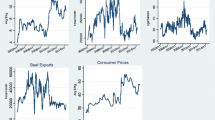Abstract
This study examines a price relationship among domestic South Korean (hereafter, Korea) premium beef, “Hanwoo,” non-premium beef, “Yukwoo,” and imported beef from the USA and Australia. In our study, we utilize monthly data from Korea Institute for Animal Products Quality Evaluation and the Global Trade Atlas from the period between January 2009 and December 2016. We model a directed acyclic graph and employ the Granger causality test and variance decomposition methods. The results show that based on the price relationship, the imported beef products compete with Yukwoo, and not with Hanwoo. Our findings imply that Korean consumers consider Hanwoo to be different from imported beef.

Source: Korea Trade Statistics Promotion Institute

Source: Korea Trade Statistics Promotion Institute


Similar content being viewed by others
Notes
“Yukwoo” in Korean means dairy beef cattle. Dependent almost entirely on Holstein bull calves, it accounts for about 10% of the domestic beef production in Korea.
The stone index utilized by the linear approximation of AIDS causes certain econometric and theoretical problems (Henningsen 2017).
References
Awokuse TO, Xie R (2015) Does agriculture really matter for economic growth in developing countries? Can J Agric Econ/Revue canadienne d’agroeconomie 63(1):77–99
Bessler DA, Akleman DG (1998) Farm prices, retail prices, and directed graphs: results for pork and beef. Am J Agric Econ 80(5):1144–1149
Chen B, Saghaian SH (2016) Market integration and price transmission in the world rice export markets. J Agric Resour Econ 41(3):444
Dwyer GP (2015) The Johansen tests for cointegration. White Paper
Engle RF, Granger CW (1987) Co-integration and error correction: representation, estimation, and testing. Econom J Econ Soc 55:251–276
Granger CW (1969) Investigating causal relations by econometric models and cross-spectral methods. Econom J Econom Soc 37:424–438
Hassanzoy N, Ito S, Isoda H, Amekawa Y (2017) Cointegration and spatial price transmission among wheat and wheat-flour markets in Afghanistan. Appl Econ 49(30):2939–2955
Hayes DJ, Wahl TI, Williams GW (1990) Testing restrictions on a model of Japanese meat demand. Am J Agric Econ 72(3):556–566
Henningsen A (2017) Demand analysis with the “Almost Ideal Demand System” in R: Package micEconAids. https://rdrr.io/cran/micEconAids/f/inst/doc/micEconAids_vignette.pdf
Hur SJ, Park GB, Joo ST (2008) A comparison of the meat qualities from the Hanwoo (Korean native cattle) and Holstein steer. Food Bioprocess Technol 1(2):196–200
Johansen S (1988) Statistical analysis of cointegration vectors. J Econ Dyn Control 12(2–3):231–254
Johansen S, Juselius K (1990) Maximum likelihood estimation and inference on cointegration—with applications to the demand for money. Oxf Bull Econ Stat 52(2):169–210
John A (2013) Price relations between export and domestic rice markets in Thailand. Food Policy 42:48–57
Kim G, Mark T (2017) Impacts of corn price and imported beef price on domestic beef price in South Korea. Agric Food Econ 5(1):5
Kim BC, Rhee MS, Ryu YC, Imm JY, Koh KC (2001) Early postmortem processing conditions on meat quality of Hanwoo (Korean Native Cattle) beef during storage. Asian-Aust J Anim Sci 14(12):1763–1768
KREI (2017) Agriculture Outlook 2017 Korea. Korea Rural Economic Institute (KREI), Seoul
KREI (2018) Agriculture Outlook 2018 Korea. Korea Rural Economic Institute (KREI), Seoul
Pearl J (1995) Causal diagrams for empirical research. Biometrika 82(4):669–688
Perron P (1989) The great crash, the oil price shock, and the unit root hypothesis. Econom J Econom Soc 57:1361–1401
Phillips PC, Perron P (1988) Testing for a unit root in time series regression. Biometrika 75(2):335–346
Rapsomanikis G, Hallam D, Conforti P (2006) Market integration and price transmission in selected food and cash crop markets of developing countries: review and applications. In: Agricultural commodity markets and trade, pp 187–217
Ryan T, Cheetham A (2017) The Korean beef market: insights and prospects from an Australian perspective. Meat & Livestock Australia Market Information Report, 6(11)
Saghaian SH, Hasan MF, Reed MR (2002) Overshooting of agricultural prices in four Asian economies. J Agric Appl Econ 34(1):95–109
Seok JH, Kim G, Reed MR, Kim S-E (2018) The impact of avian influenza on the Korean egg market: who benefited? J Policy Model 40(1):151–165
Zivot E, Andrews DWK (2002) Further evidence on the great crash, the oil-price shock, and the unit-root hypothesis. J Bus Econ Stat 20(1):25–44
Author information
Authors and Affiliations
Corresponding author
Ethics declarations
Conflict of interest
The authors whose names are listed immediately below certify that they have NO affiliations with or involvement in any organization or entity with any financial interest (such as honoraria; educational grants; participation in speakers’ bureaus; membership, employment, consultancies, stock ownership, or other equity interest; and expert testimony or patent-licensing arrangements), or nonfinancial interest (such as personal or professional relationships, affiliations, knowledge or beliefs) in the subject matter or materials discussed in this manuscript.
Additional information
Publisher's Note
Springer Nature remains neutral with regard to jurisdictional claims in published maps and institutional affiliations.
Rights and permissions
About this article
Cite this article
Moon, H., Seok, J.H. Price relationship among domestic and imported beef products in South Korea. Empir Econ 61, 3541–3555 (2021). https://doi.org/10.1007/s00181-021-02014-6
Received:
Accepted:
Published:
Issue Date:
DOI: https://doi.org/10.1007/s00181-021-02014-6




